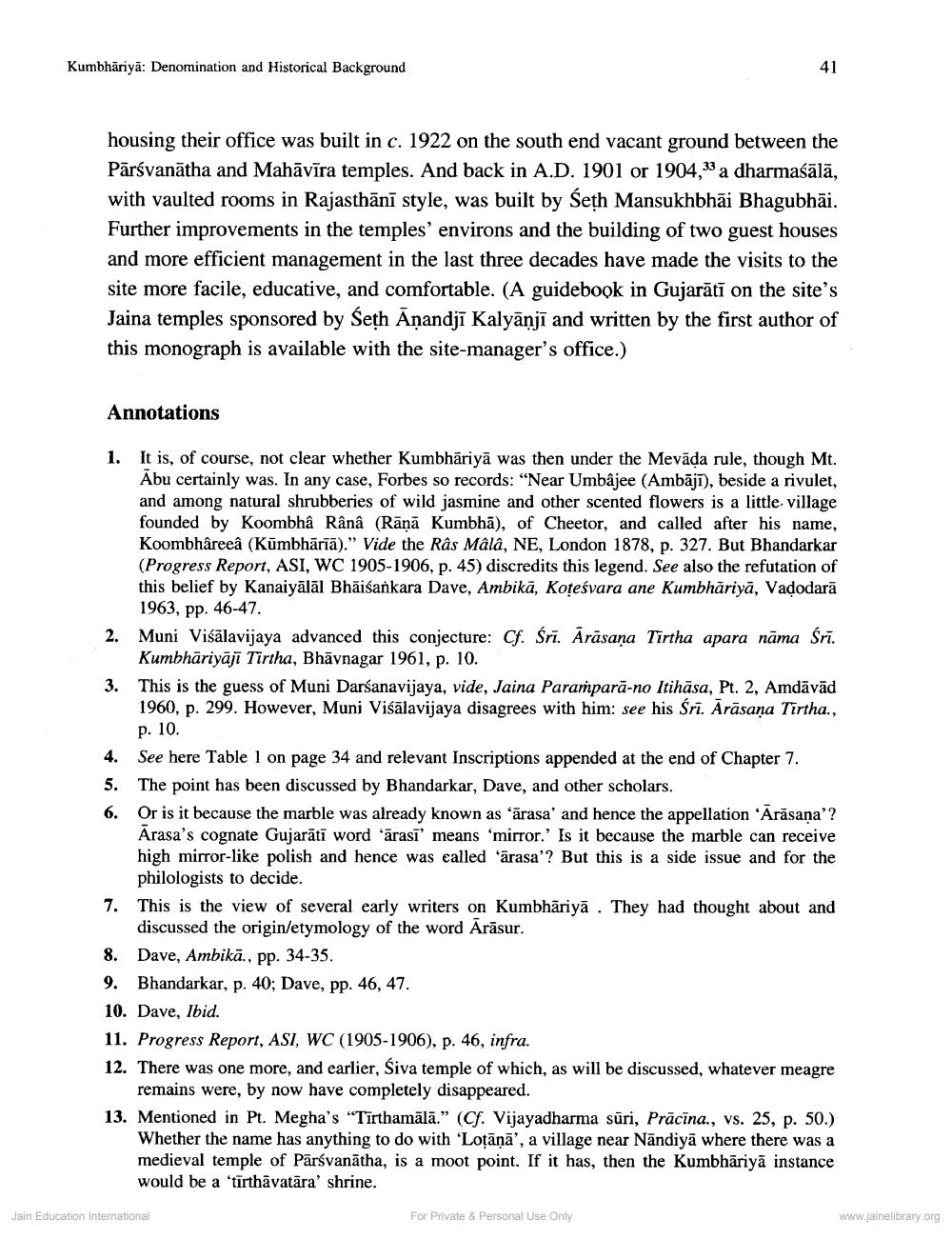________________
Kumbhäriya: Denomination and Historical Background
housing their office was built in c. 1922 on the south end vacant ground between the Pārsvanātha and Mahāvīra temples. And back in A.D. 1901 or 1904,33 a dharmaśālā, with vaulted rooms in Rajasthānī style, was built by Seth Mansukhbhāi Bhagubhāi. Further improvements in the temples' environs and the building of two guest houses and more efficient management in the last three decades have made the visits to the site more facile, educative, and comfortable. (A guidebook in Gujarātī on the site's Jaina temples sponsored by Seth Anandji Kalyānjī and written by the first author of this monograph is available with the site-manager's office.)
Annotations
2.
1. It is, of course, not clear whether Kumbhāriyā was then under the Mevāda rule, though Mt.
Abu certainly was. In any case, Forbes so records: "Near Umbajee (Ambājī), beside a rivulet, and among natural shrubberies of wild jasmine and other scented flowers is a little village founded by Koombha Rânâ (Rāṇā Kumbhā), of Cheetor, and called after his name, Koombhâreeâ (Kumbhäriā)." Vide the Râs Mâlâ, NE, London 1878, p. 327. But Bhandarkar (Progress Report, ASI, WC 1905-1906, p. 45) discredits this legend. See also the refutation of this belief by Kanaiyālāl Bhāiśankara Dave, Ambikā, Koțeśvara ane Kumbhāriyā, Vadodarā 1963, pp. 46-47. Muni Viśālavijaya advanced this conjecture: Cf. Śrī. Ārāsana Tirtha apara nāma Śrī.
Kumbhāriyāji Tirtha, Bhāvnagar 1961, p. 10. 3. This is the guess of Muni Darśanavijaya, vide, Jaina Paramparā-no Itihāsa, Pt. 2, Amdāvād
1960, p. 299. However, Muni Viśālavijaya disagrees with him: see his Śrī. Arāsaņa Tirtha.,
p. 10. 4. See here Table 1 on page 34 and relevant Inscriptions appended at the end of Chapter 7. 5. The point has been discussed by Bhandarkar, Dave, and other scholars.
Or is it because the marble was already known as 'ārasa' and hence the appellation 'Arāsana'? Arasa's cognate Gujarāti word 'ārasī' means 'mirror.' Is it because the marble can receive high mirror-like polish and hence was called ärasa'? But this is a side issue and for the philologists to decide. This is the view of several early writers on Kumbhāriyā . They had thought about and
discussed the origin/etymology of the word Ārāsur. 8. Dave, Ambikā., pp. 34-35. 9. Bhandarkar, p. 40; Dave, pp. 46, 47. 10. Dave, Ibid. 11. Progress Report, ASI, WC (1905-1906), p. 46, infra. 12. There was one more, and earlier, Siva temple of which, as will be discussed, whatever meagre
remains were, by now have completely disappeared. 13. Mentioned in Pt. Megha's "Tīrthamālā.” (Cf. Vijayadharma sūri, Prācīna., vs. 25, p. 50.)
Whether the name has anything to do with 'Loțāņā', a village near Nāndiyā where there was a medieval temple of Pārsvanātha, is a moot point. If it has, then the Kumbhāriyā instance would be a 'tirthāvatāral shrine.
Jain Education International
For Private & Personal Use Only
www.jainelibrary.org




